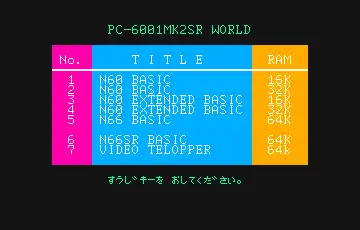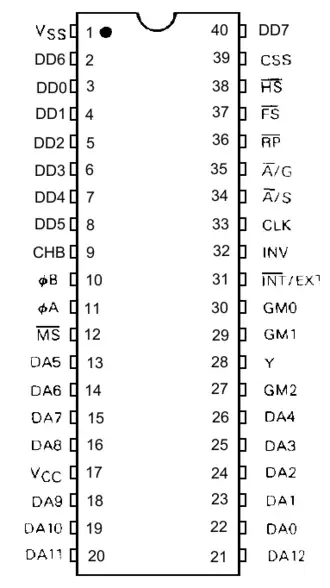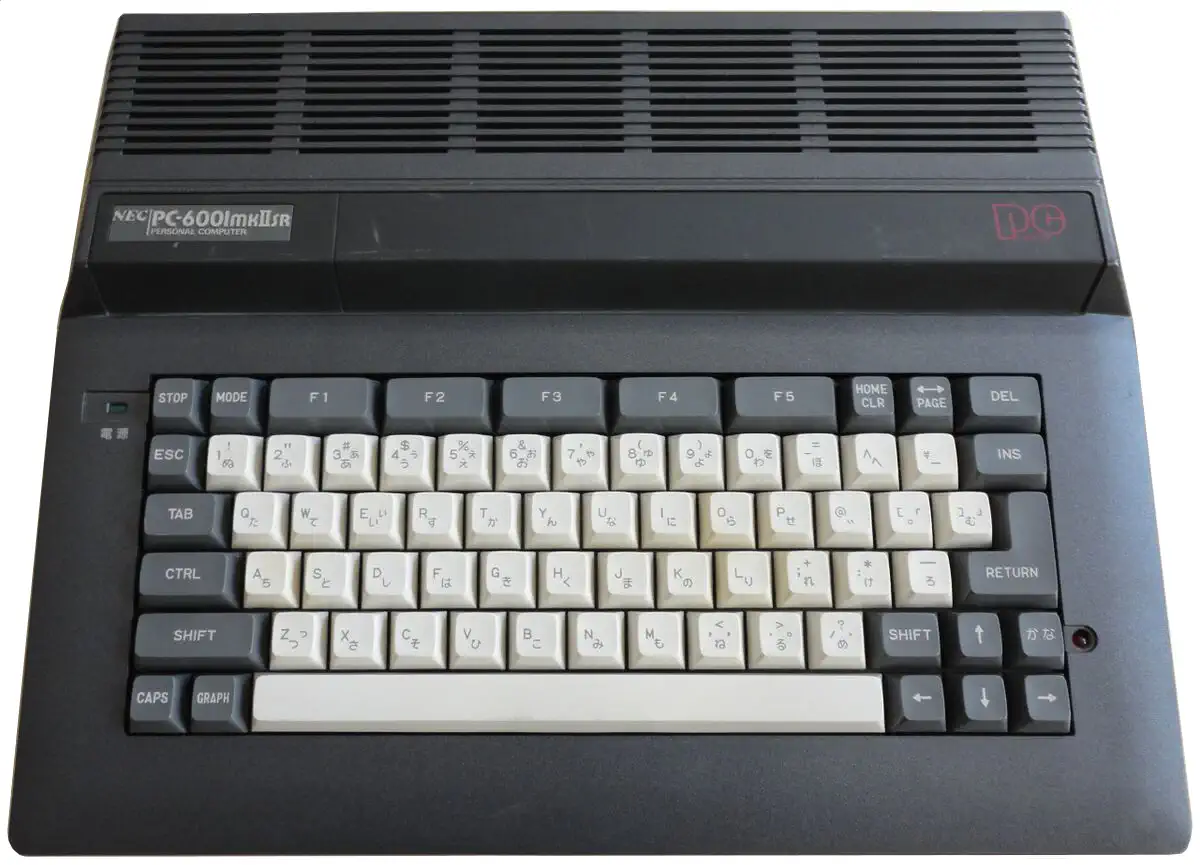NEC PC 6001 mkII SR
The PC-6001 mkII SR was released in 1984 by NEC as an upgrade to the PC-6001 mkII. It is compatible with all the previous PC-6001 models, but has new features.
PC-6001 Mk2 SR also has an FM synth accessible in N66SR BASIC, specifically: Yamaha YM2203. It allows playback of 3 additional channels for FM instruments. Together with the Voice Synthesis module, this greatly improved the musical capabilities of this computer over its predecessor.

Programmable Sound Generator (AY-3-8910 compatible PSG)
The AY-3-8910 is a 3-voice Programmable Sound Generator, or PSG. It was designed by General Instrumet in 1978 for use with their own 8-bit PIC1650 and their 16-bit CP1610 computers.
The PSG is widely used in many arcade cabinets, pinball machines, and many micro-computers. Here is a list of some of the major brands of computer that used the AY-3-8910:
- Intellivision
- Vectrex
- Amstrad CPC range
- Oric-1
- Color Genie
- Elektor TV Games Computer
- All MSX-1 and MSX-2 computers
- ZX Spectrum home computers
General Instrument spun of MicroChip Technology in 1987 and the chip was sold under the MicroChip brand, and licensed to Yamaha as the YM2149F which the Atari ST range of computers use. Functionally the PSG is very similar to the Texas Instruments SN76489.
Variants:
-
AY-3-8910
Comes with 2 general purpose 8-bit parallel I/O ports, used for Keyboard and Joystick in for instance MSX. -
AY-3-8912
Same chip, but in a 28-pin package. Parallel port B is not connected to save cost and space. -
AY-3-8913
Same chip, but in a 24-pin package. Both parallel ports are not connected. -
AY-3-8914
The AY-3-8914 has the same pinout and is in the same 40-pin package as the AY-3-8910, except the control registers on the chip are shuffled around, and the 'expected input' on the A9 pin may be different. It was used in Mattel's Intellivision console and Aquarius computer. -
AY-3-8930
Backwards compatible but BC2 pin is ignored
YM2149F -
YM3439-D
CMOS version of the Y2149 in 40-pin DIP -
YM3439-F
CMOS version of the Y2149 in 44-pin QFP -
YMZ294
Variant of the YM3249 in an 18-pin package. Parallel ports not connected, and all sound channels mixed on 1 port. -
T7766A
Toshiba variant of the AY-3-8910, fully compatible. Used in some MSX models. - Winbond WF19054, JFC95101, and File KC89C72: Fully compatible versions of the AY-3-8910 produced for slot machines.
Yamaha Produced chip, same pin-out as the AY-3-8910, but pin 26 could halve the master clock. Can be used to replace the AY-3-8910 if pin 26 is left disconnected.
Motorola MC6847 Video Display Generator
The MC6847 is a video display generator (VDG) first introduced by Motorola and used in the following machines (this is not a full list):
- TRS-80 Color Computer
- Dragon 32/64
- Laser 200
- TRS-80 MC-10/Matra Alice
- NEC PC-6000 series
- Acorn Atom
- APF Imagination Machine
The VDG is a relatively simple display generator compared to other display chips of the time. It is capable of displaying alphanumeric text, semigraphics and raster graphics contained within a roughly square display matrix 256 pixels wide by 192 lines high.
The ROM includes a 5 x 7 pixel font, compatible with 6-bit ASCII. Effects such as inverse video or colored text (green on dark green; orange on dark orange) are possible.
The MC6847 is capable of displaying nine colors:
- black
- green
- yellow
- blue
- red
- buff (almost-but-not-quite white)
- cyan
- magenta
- and orange

Motorola MC6845 Video Display Generator
The Motorola 6845 or MC6845 is a display controller that was widely used in 8-bit computers from the 1980s. The chip was initially designed to coexist alongside the 6800 CPU, but many manufacturers used it in their z80 and MOS6502 architectures as well.
The 6845 has as main function to regulate timing access to display memory, or VRAM. Other circuitry then uses the address generated by the 6845 to fetch the content of the memory and create the image. While the chip was designed for character display, with some programming pixel graphics could also be displayed.
The functionality and design of the 6845 has been a blue-print for later EGA and VGA graphics cards for the IBM-PC compatibles.

Zilog Z80 CPU Family
The Z80 quickly became popular in the personal computer market, with many early personal computers, such as the TRS-80 and Sinclair ZX80, using the Z80 as their central processing unit (CPU). It was also widely used in home computers, such as the MSX range, SORD, and the Amstrad CPC, as well as in many arcade games. Additionally, it was also used in other applications such as industrial control systems, and embedded systems. The Z80 was widely used until the mid-1980s, when it was gradually replaced by newer microprocessors such as the Intel 80286 and the Motorola 68000.
The Z80 microprocessor was developed by Zilog, a company founded by Federico Faggin in 1974. The Z80 was released in July 1976, as a successor to the Intel 8080. It was designed to be fully compatible with the 8080, but also included new features such as an improved instruction set, more powerful interrupts, and a more sophisticated memory management system.
The Z80 quickly became popular in the personal computer market, with many early personal computers, such as the TRS-80 and Sinclair ZX80, using the Z80 as their central processing unit (CPU). It was also widely used in home computers, such as the MSX range, SORD, and the Amstrad CPC, as well as in many arcade games. Additionally, it was also used in other applications such as industrial control systems, and embedded systems. The Z80 was widely used until the mid-1980s, when it was gradually replaced by newer microprocessors such as the Intel 80286 and the Motorola 68000. The design was licensed to Synertek and Mostek as well as the European SGS.
The Z80s instruction set is binary compatible with the Intel 8080, so that 8080 code such as the CP/M Operating System and Intel's PL/M compiler for the 8080 can run unmodified on the Z80. The Z80 had many enhancements over the 8080 such as 16-bit data movement instructions, block copy and block I/O instructions, single bit addressing of all registers, IX/IY offset registers, better interrupt system and a complete duplicate register file for context switching during an interrupt.
Source: WikiPedia

1 noise generator
16 volume levels
Voice Synthesis
FM Sound Display Chip 6847 & 6845 graphic chipsets Display Text mode, 160x200 in 15 colors, 320x200 in 4 colors Best Color 15 colors Best Graphics 320x200 in 4 colors Sprites none System OS N66 Extended BASIC Storage External Tape, External disk drives. Original Price #349
The MC6847 is a Video Display Generator (VDG) first introduced by Motorola in 1978

